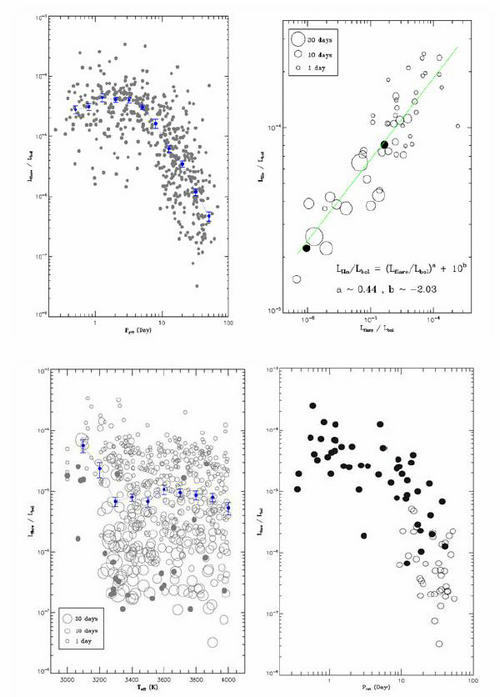Recently, the Chinese astronomers Huiqin Yang and Jifeng Liu et al have revealed the relationship between the stellar activities of M-type dwarfs and their rotation periods, as well as the relationship of the energy release in different layers of stellar atmosphere. Those results have made an important contribution to the study of the stellar structure and evolution.
A comprehensive study of the flare activity of M dwarfs was carried out in combination with Kepler light-curve and LAMOST spectra. The flare activity is defined as the ratio of the flare luminosity to the stellar luminosity, i.e., Lflare /Lbol. It is found that its relation with the rotation can be described with three phases, and the released energies in different layers of stellar atmosphere have a power law relation. Moreover, it is also proved that stellar activity is greatly improved during the dynamo transition. The above conclusions reveal the details of the stellar activity, the mechanism of the internal energy release, and confirm the theoretical predictions of the stellar dynamo. The results have been published recently in The Astrophysical Journal.
Stellar flares are intense energy outburst events on the stellar surface lasting for hours, and are an important indicator of stellar activity. Before the Kepler Mission, the study of stellar activity mainly use spectral emission lines (such as Ca II, Ha etc), rotation periods or X ray luminosities. But little is known about the more direct events of stellar activity -- the flare. The Kepler Space Observatory records numerous stars with unprecedented high photometric precision in flux measurements. It is thus perfectly suitable for conducting a statistical study of flares.
Since stellar flares are the results of magnetic reconnection, the strength and the morphology of the magnetic field have a decisive influence on stellar activity. According to the traditional stellar dynamo theory, the strength of the magnetic field is mainly determined by the depth of convection envelope and the rotational period, but the details of the relations, such as the mechanism of energy release and energy transition between the different layers of the atmosphere, are not clear. Moreover, the dynamo theory predicts that when the star become fully convective (near M4), the stellar dynamo will change completely, and the stellar activity will be greatly improved. However, there is no direct evidence because of the observational limitation.
Through the study of more than one hundred thousand white light flare events of 540 M dwarfs, the researchers found that the flare activity vs. the rotation period has three phases, i.e., super saturation, saturation, and exponential decay, corresponding to an ultra-short period, a short period, and a long period. It is shown in the upper left panel of the figure. Further studies have found that the centrifugal stripping theory is the main reason for the supersaturation. By comparing the normalized Ha luminosity with the flare activity, the researchers obtained a good exponential relation. As shown in the upper right panel of the figure, the relation reveals the energy release relationship, the mechanism of the superflare and so on. Based on the relationship between flare energies and spectral types, the researchers find that the stellar activity was greatly improved after the full convection (about M4). This is the most direct and powerful evidence for the stellar dynamo theory. The relation is shown in the bottom left panel of the figure. Moreover, by comparing the energy, the rotation period and the emission line, the researchers find that the rotation period of 10 days can be used as the boundary for the active and inactive stars.

The upper left panel is relation between flare activity and period. The upper right panel is relation between flare activity and Ha activity. The bottom left panel is relation between flare activity and temperature. The bottom right panel is relation between active stars, inactive stars and period.

Address: 20A Datun Road, Chaoyang District, Beijing, China code: 100012
Tel: 010-64888708 E-mail: naoc@nao.cas.cn

